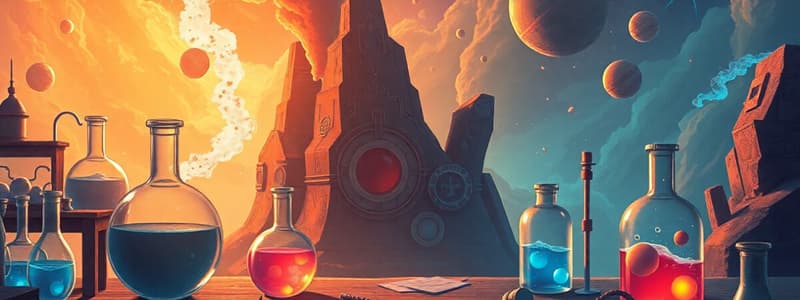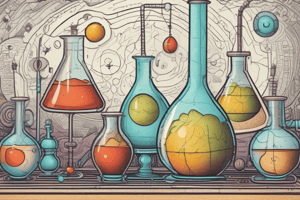Podcast
Questions and Answers
A researcher aims to study the effect of a new fertilizer on plant growth. Which variable represents the plant growth?
A researcher aims to study the effect of a new fertilizer on plant growth. Which variable represents the plant growth?
- Confounding variable
- Dependent variable (correct)
- Independent variable
- Controlled variable
Which of the following questions falls outside the scope of scientific inquiry?
Which of the following questions falls outside the scope of scientific inquiry?
- How does the introduction of a new predator affect the population size of its prey?
- What is the most ethical way to distribute limited healthcare resources? (correct)
- What are the physical properties of a newly discovered element?
- How does increased carbon dioxide concentration affect global temperatures?
A scientist observes that the average lifespan of a certain species of butterfly is consistently 2 weeks in a lab environment. Which of the following best describes this finding?
A scientist observes that the average lifespan of a certain species of butterfly is consistently 2 weeks in a lab environment. Which of the following best describes this finding?
- Qualitative data
- A scientific law (correct)
- A scientific theory
- A hypothesis
Which of the following characteristics is essential for scientific knowledge to be considered valid?
Which of the following characteristics is essential for scientific knowledge to be considered valid?
A study finds a correlation between increased screen time and decreased physical activity in adolescents. What is the next step in the scientific method to further investigate this?
A study finds a correlation between increased screen time and decreased physical activity in adolescents. What is the next step in the scientific method to further investigate this?
Which of the following best illustrates homeostasis in a living organism?
Which of the following best illustrates homeostasis in a living organism?
Which characteristic distinguishes Archaebacteria from Eubacteria?
Which characteristic distinguishes Archaebacteria from Eubacteria?
Which of the following lists the correct order of taxonomic classification from broadest to most specific?
Which of the following lists the correct order of taxonomic classification from broadest to most specific?
What is the primary function of lipids in the context of energy storage?
What is the primary function of lipids in the context of energy storage?
How does hydrogenation affect the properties of unsaturated fats?
How does hydrogenation affect the properties of unsaturated fats?
What type of molecule are enzymes and what is their function?
What type of molecule are enzymes and what is their function?
How does the denaturing affect the functionality of a protein?
How does the denaturing affect the functionality of a protein?
How many calories are in 10 grams of fat vs 10 grams of protein?
How many calories are in 10 grams of fat vs 10 grams of protein?
Flashcards
Scientific Knowledge
Scientific Knowledge
Knowledge gained through observation, measurement, and testing.
Hypothesis
Hypothesis
A tentative explanation for an observed phenomenon, testable through experimentation.
Independent Variable
Independent Variable
Factor changed or manipulated in an experiment.
Data: Quantitative vs. Qualitative
Data: Quantitative vs. Qualitative
Signup and view all the flashcards
Theory
Theory
Signup and view all the flashcards
Heterotrophic
Heterotrophic
Signup and view all the flashcards
Autotrophic
Autotrophic
Signup and view all the flashcards
Homeostasis
Homeostasis
Signup and view all the flashcards
Taxonomy
Taxonomy
Signup and view all the flashcards
Binomial Nomenclature
Binomial Nomenclature
Signup and view all the flashcards
Lipids (Fats)
Lipids (Fats)
Signup and view all the flashcards
Amino Acid
Amino Acid
Signup and view all the flashcards
Enzymes
Enzymes
Signup and view all the flashcards
Study Notes
- Scientific knowledge is empirical, objective, quantifiable, predictable, testable, reproducible and self-correcting,
- Scientific knowledge requires highly controlled conditions and clearly defined terminology.
- Science cannot answer questions of ethics or solve political problems.
- Science cannot explain something unobservable or untestable, such as faith
- Art, philosophy, literature, ethics, and religion are alternative ways to answer questions.
- The purpose of science is to better understand the natural world.
Scientific Methods
- Observations and questions.
- Hypothesis development and prediction.
- Testing and gathering data.
- Evaluating results.
- Reporting results.
Hypothesis Testing
- Controlled experiments are essential for testing a hypothesis.
- Independent variable: manipulated.
- Controlled variable: Constant.
- Dependent variable: the result.
- Confounding variable: interferes with results.
- Prediction structure: If (independent variable), then (dependent variable), because (hypothesis).
- Data can be ordinal/quantitative (height, weight, scores) or nominal/qualitative (texture, colors, sounds).
Theory vs. Law
- Theory: Explanations supported by empirical evidence.
- Examples include germ theory, cell theory, gene theory, and the theory of evolution by natural selection.
- Law: Describes natural phenomena, such as thermodynamics and gravity.
Levels of Biological Organization
- Cells Tissues
- Organs
- Organisms
- Populations
- Communities
ATP
- ATP is a molecule that all living things produce.
- Death occurs when a living thing stops producing ATP.
Characteristics of Living Things
- Exhibit heterotrophic (taking from other living things) or autotrophic (giving to other living things) nutrition.
- Maintain homeostasis to survive(internal wellbeing).
- Response to Stimuli: (sweating).
- Living things Reproduce, grow, and evolve.
Diversity of Life
- Eubacteria: true bacteria.
- Archaebacteria: ancient bacteria.
- Eukarya: true nucleus.
Kingdoms of Life
- Bacteria.
- Archaea.
- Protista.
- Fungi.
- Animalia.
- Taxonomy is the system of classification.
- Kingdoms are groups that reflect evolutionary closeness.
- Levels of classification: Kingdom, Phylum, Class, Order, Family, Genus, species.
- Genus and species make up the Binomial Nomenclature, with species in lowercase.
Facts about Fat
- Fat cells last about 8 years.
- There are several different types of fat in the body.
- All extra calories are stored as fat.
- Lipids store energy, and sterols assist with development.
- Lipids provide 9 calories per gram.
- Lipids Unit Molecule = Fatty Acid (nonpolar).
- Function Structure: cell membranes (made of phospholipids, fatty acid chains & phosphate molecules).
- Cell membrane marks the boundary for the cell.
- Function energy: Glycerides (glycerol +fatty acid chains, there are three types, mon-, di-, triglycerides).
- Hydrogenated plant fats (trans fat) are not healthy.
- Sterol Unit Molecule = cholesterol.
- Sex hormones.
- Glucocorticoids (reduce inflation).
Saturated Fats
- Solid at room temperatures.
- Stored as fat in the body.
Unsaturated Fats
- Liquid at room temperatures.
- Less likely to be stored as body fat.
Hydrogenation
- Is the artificial addition of hydrogen atoms to an unsaturated fat.
- Proteins are versatile building blocks providing 4 calories per gram.
- A single amino acid is the Unit Molecule (20 different types).
- Amino Acid covalent bonds are called peptide bonds
- Proteins are an Essential dietary component with many types.
- Complex shapes determine the function of proteins.
- Denaturing changes the shape of the protein.
- Enzymes, essential to all metabolic reactions, are named by what they catalyze; they are chemical catalysts.
- Nucleic acids store information on how to function the body, caloric value varies.
- A nucleotide is a Unit molecule.
- Function: energy (chemical bond)
- Types: ATP ADP.
- Examples: DNA- RNA- Protein.
- All life obeys the 1st and 2nd laws of Thermodynamics.
- Energy cannot be created or destroyed, but can be transformed.
Cellular Metabolism
- To stay alive (organized), organisms must take energy from their environment.
- Entropy is the transition from organized to disorganized state.
- Kinetic energy: motion
- Potential energy: stored
- Energy comes from food with potential (chemical) energy.
- ATP is recycled to release energy from food for work.
- Glucose stores a lot of energy, but cellular activities require smaller amounts.
- Excess energy is lost as heat.
- 1 glucose yields 36-38 ATP's.
Studying That Suits You
Use AI to generate personalized quizzes and flashcards to suit your learning preferences.




